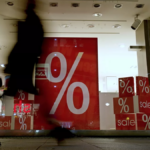Investors are increasing bets Europe will sink into a painful economic downturn, in a growing contrast to the conviction in financial markets that the US is headed for a “soft landing”.
The euro has fallen against the dollar over the past two weeks, while the surprise ascent of European shares this year has stalled, and German government bonds — investors’ preferred retreat in times of stress — are gaining in price.
The shifts show growing confidence among fund managers that economic indicators in the eurozone are weakening in the face of higher borrowing costs, while the US has demonstrated resilience despite the most restrictive interest rate environment in 22 years.
“We’ve seen a lot of interest rate hikes in the US, but demand and growth are strong,” said Ario Emami Nejad, portfolio manager at Fidelity International.
“The European growth dynamic is weak; we think the [European Central Bank] has made a policy mistake and they will recognise this late,” he added, referring to the idea that the ECB has hoisted borrowing costs too high and will be forced to cut them.
Official figures last week showed the US economy grew at an annualised rate of 2.4 per cent in the second quarter, well above what economists had forecast, while the US Federal Reserve’s preferred gauge of inflation cooled more than expected in June, bolstering expectations it can soon call time on its rate-raising cycle. Meanwhile, Europe has been teetering on the brink of recession, while services inflation in the eurozone hit a record of 5.6 per cent in July.
Analysts said interest rate rises had been less successful at bringing down inflation in Europe than the US, because a larger proportion of inflation had been down to the damage inflicted in food and energy supplies by Russia’s all-out invasion of Ukraine.
In the first half of this year, European equity markets were a surprise hit, confounding analysts’ almost universal expectation of declines. Instead, a relatively mild winter and easing of the region’s energy crisis helped the continent to avoid a deep shock, and propel the Stoxx Europe 600 index 8.5 per cent per cent higher in the first six months of the year.
Those gains have gone into reverse midway through a disappointing second-quarter earnings season. Companies on the Stoxx 600 are on track to deliver their biggest decline in quarterly profits since the early stages of the Covid-19 pandemic, reporting a 17 per cent year-on-year drop in earnings per share in the second quarter, more than double the fall of US rivals in its benchmark S&P 500.
Accordingly, the share price gap with Wall Street has widened. The S&P 500 is up almost 20 per cent this year, helped in part by enthusiasm over artificial intelligence — an area dominated by US companies.
Source : FINANCIAL TIMES

















Add Comment